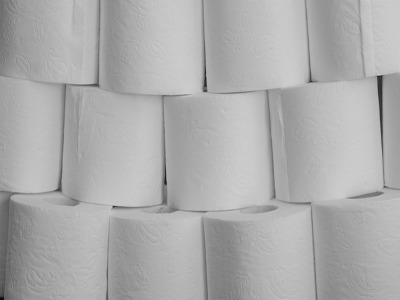Most of us don’t know life without toilet paper. A typical American uses more than 100 rolls of toilet paper every year. Toilet paper is also called toilet tissue or bathroom tissue. It is a tissue that is mainly used for cleaning the anus and external genitalia after urination. It is usually stored in a long strip of punched paper, which is wrapped around a paperboard core. Toilet paper is designed to decompose in septic tanks, while other papers like bathroom, kitchen, and facial tissues don’t dissolve. Toilet papers are available in different types of paper. They have different patterns, decorations, textures, and so on. Sometimes they are moistened or even perfumed. Toilet papers are usually 10 cm wide and 12 cm in diameter. Toilet papers are also described by sheet ply, which refers to the number of layers per sheet. Usually, you can get the rolls in single-, 2-, 3-, or 4-ply. Before toilet paper, people used to use natural tools to clean themselves. For example, they used stones, leaves, animal fur, and seashells, and they rinsed themselves with water or snow. The Romans used to use L-shaped sticks. In public toilets, people used sponges on sticks, and between uses, they were kept in saltwater. Toilet paper became more popular in the late 15th century.
Toilet paper is made out of new paper or “virgin paper”, and it is made with a combination of soft and hardwood trees. The purpose of softwood is to give strength to the paper because the fibers are long. Hardwood trees have shorter fibers, and therefore the paper is softer. In toilet paper, there is usually 70% hardwood and 30% softwood. In the process of making the toilet paper, there is also use of water, chemicals, and bleaches. If the toilet paper is made from recycled paper, then companies also have to use oxygen, ozone, sodium hydroxide, or peroxide to whiten the paper.
Like already mentioned above, people used natural tools to clean themselves. Other than the sponge on the stick, archaeologists have also found samples of pessoi. It is a small, oval- or round-shaped ceramic that is made out of pebbles. It was used by ancient Greeks and Romans. There is even a drawing of a 2700-year-old drinking cup where you can see a squatting man who is using this pessoi. Archaeologists also discovered another type of “ancient toilet paper” on the ancient Silk Road. It was a “hygiene stick”. It was made out of bamboo or wood, and it was wrapped in cloth. The sticks that the archaeologists discovered were 2000 years old. The “hygiene stick” or spatulas were used in China and Japan.
The earliest signs of using “modern-day” toilet paper come from China. The proof for it was found in materials that were written by Yen Chih-Thui and were from the sixth century A.D. Scientists also found that, already in the second century A.D., people may have used paper to clean themselves. It was made out of hemp. The proof for it was found in Emperor Wu Di’s tomb.
In 1393, rice-based toilet paper was manufactured for the Chinese imperial family. At the end of the 14th century, China had manufacturers for toilet paper. They produced 10 million packages of toilet paper annually. They also produced perfumed toilet paper. In the Western world, mass production of toilet paper did not begin until 1857. That same year, Joseph Gayetty introduced “medical paper” for water closets to help Americans avoid using newspapers, corn cobs, or similar products to clean themselves. Joseph Gayetty printed his name on every sheet, but his project failed. In 1897, the Scott brothers founded The Scott Paper Company, which was the first company to sell toilet paper in rolls. In 1897, Walter Alcock, who was an English businessman, also started a company, that sold perforated toilet rolls and he started to sell them in boxes. In 1885, Oliver Hewlett patented a toilet paper package. In 1928, Hans Klenk, a German, started selling toilet paper rolls for the first time in Europe.
In history, there have also been times when people were afraid that there would be a shortage of toilet paper, so they “panic bought” it. The latest one was in 2020, during the coronavirus pandemic. When all the stores were out of toilet paper. There was also a toilet paper shortage in Japan in 1973. Japanese women started to buy huge amounts of toilet paper. It was a reaction to growing fears in Japan’s middle classes that their post-war aspirations for peace, stability, and economic stability would be destroyed by inflation, environmental degradation, and the oil crisis. The hoarding of toilet paper in Japan also made the U.S. people concerned.
In conclusion, nowadays, the toilet paper industry is the biggest industry in the world. Using toilet paper has made our lives easier and more hygienic.

Sources:
https://en.wikipedia.org/wiki/Toilet_paper
http://www.madehow.com/Volume-6/Toilet-Paper.html
https://www.history.com/news/toilet-paper-hygiene-ancient-rome-china
https://www.nationalgeographic.com/history/article/what-people-do-before-toilet-paper
http://www.toiletpaperhistory.net/toilet-paper-history/history-of-toilet-paper/
